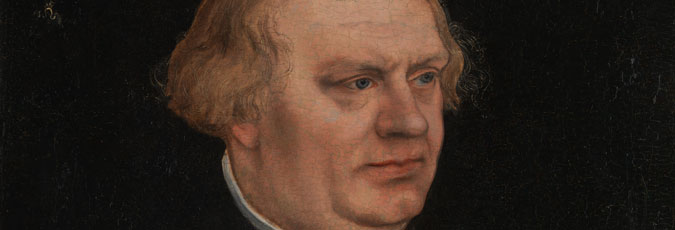Subject
The sitter’s hair is grey-brown and his eyes are blue. He wears a high-necked white shirt under a black, diamond-patterned coat. A grey metal-framed purse made from a black textile hangs from his belt. The coat of arms top left (fig. 2) is described as ‘Coupé: au 1 d’argent aux trois figues de vert; au 2 de gueules’ and that top right as ‘De gueules á la fasce d’or, accompagné de trois oeillets[?] au naturel’.5 The coat of arms on the left is surmounted by a crest of an imperfectly preserved female demi-figure possibly crowned with green and holding a green object (see Conservation and Condition), probably a branch with green leaves; that on the right by two wings which repeat the gold band or fess and flowers of the coat of arms.
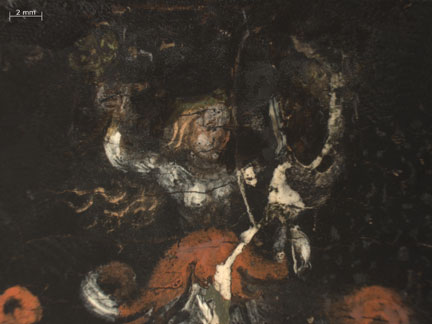
The coat of arms upper left closely resembles that of Johann Feige, Chancellor of Hesse (1482?–1543). ‘Feige’ is the German word for fig. On 29 December 1517 the Emperor Maximilian bestowed on Feige a grant of arms identical to that shown upper left (fig. 3). It has been suggested that the arms upper right may represent those of his mother, Margaret Mehrgart.6 Feige’s date of birth is estimated from the knowledge that he was studying at the University of Erfurt in 1503. He was made chancellor of Hesse on 6 July 1514 and remained so to the end of 1542. He served the Landgrave Philip the Magnanimous of Hesse, on whose behalf he carried out diplomatic missions. He became on 1 July 1527 the first chancellor of the Protestant Marburg University, founded in the same year by the Landgrave Philip, and remained chancellor until 1536. Feige moved in the Protestant circles that patronised Cranach and is likely to have known the artist.7 It is plausible that Feige, one of his Protestant associates, or even the Landgrave Philip, commissioned a portrait from Cranach.
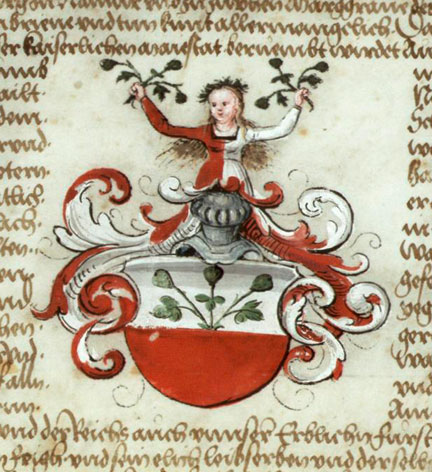
A portrait at the University of Marburg attributed to Johann Heinrich Tischbein (1751–1828) and given a date of 1771/2 is said to represent Feige (fig. 4).8 Although it shows the subject against a background of a curtain and a library, holding a book in his left hand, the portrait not only bears a strong facial resemblance to the National Gallery portrait but also shows the sitter in a tunic with exactly the same pattern. On the table is a document showing two coats of arms, the one on the right showing the three figs as here, the one on the left bearing a strong resemblance to the coat of arms on the right of NG1925. The portrait therefore must be based on NG1925, or on a copy or a variant of it. It appears to have been always in the university collections and was presumably commissioned to commemorate its first chancellor. Von Brockhusen suggested that the portrait might have been made in 1777, the 250th anniversary of the university, and that NG1925 had been lent for this purpose by the Dr Luther whose name is inscribed with the date 1778 on the reverse.9
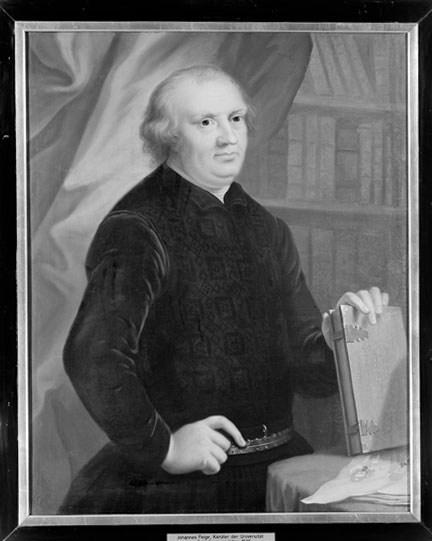
Levey, believing the date of 1524 to be reliable, thought the sitter here too old to be Feige, who would have been about forty-three in 1524.10 However, more recent examination has shown that there is little or no original paint in the positions of the digits (see Technical Notes). The traces of the third digit of the date originally inscribed, which gives the decade of the portrait, indicate it could have been a 2, 3, 5 or 7 (fig. 1). If the last two are excluded, since Cranach died in 1553, and the style and appearance of the sitter seem to belong to a period earlier than the very end of his career, the date of the portrait would be either 152[?] or 153[?]. Although the style of the subject’s hair and dress perhaps indicate the earlier of the two dates, as the sitter is not a young, fashionable man, a date in the early 1530s cannot be excluded; Feige would then have been about fifty-three, an age which might accord better with the sitter’s apparent age. The sitter in this portrait is therefore plausibly identified as Johann Feige.
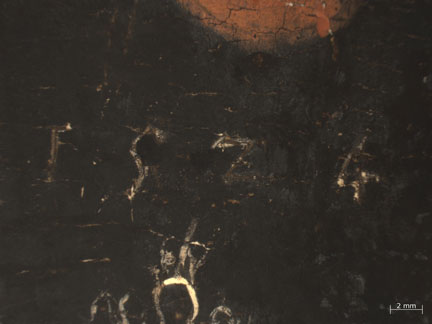
False identifications
An inscription on the back of the panel, apparently in a nineteenth-century hand, identifies the sitter as Francis von Sickingen, the anglicised first name indicating that this was inscribed when the painting was in an English collection (see Provenance). Franz von Sickingen (1481–1523) was a soldier, and leader of the German knights warring against the Emperor Charles V in the early 1520s.11 A portrait of von Sickingen said to be by Cranach is recorded in the ducal collection in Karlsruhe by 1844, but this appears to have been a larger portrait which was recorded in an engraving by Ernst Fries and should not be identified with the National Gallery work, as formerly suggested.12 An etching of von Sickingen by Hieronymous Hopfer made between 1528 and 1563 shows a bust-length figure in profile wearing armour (fig. 5).13 His hairstyle and prominent chin show a faint resemblance to the figure in the National Gallery portrait, and may have led to a nineteenth-century identification of NG1925 or a version of this portrait as von Sickingen.
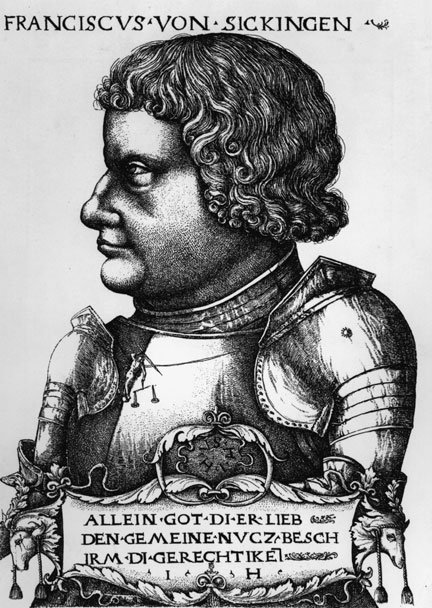
Another inscription on the back of the picture reads ‘H. Doctor/Lüther 1778’, which seems to have suggested an identification for the sitter as a member of the Luther family. It has also been interpreted as a provenance, with the suggestion that the portrait might have been owned by the lawyer Carl Friedrich Luther (1741–1797) of Darmstadt, but this cannot be confirmed.14 There is some slight resemblance to the portraits of Hans Luther, father of Martin by Cranach, a drawing in the Albertina, Vienna, and a painting in Eisenach, Wartburg Stiftung, dated 1527.15 The portraits are only superficially similar: the eyes, eyebrows and noses of the sitters differ considerably, and Hans Luther is clearly an older man.
Further sections
- Introduction
- Signature and date, provenance, exhibitions and loans
- Technical notes
- The subject
- Attribution and date
6. Von Brockhusen 1968, p. 125.
7. NDB 24, 201, 313–14.
8. Marburg University inventory no. 4100. The modern label attached to the picture frame reads ‘Johann Feige, Kanzler der Universität bei ihrer Gründung im Jahre 1527’. See von Brockhusen 1968, p. 123, who first made the connection to NG 1925. The Tischbein family were natives of Marburg, although Johann Heinrich Tischbein was born in nearby Haina. If correctly dated to 1771/2 the portrait would have been an early work before the artist moved to Rome.
9. Von Brockhusen 1968, p. 127.
10. Levey 1959, p. 20: ‘The date on the picture does not seem to have been tampered with.’
11. NDB 24, 313 ff. ADB 34, pp. 151–8.
12. Heller 1844, p. 58: ‘Franz von Sickingen. Auf holz; H. 3 Sch. 13. Br. 1 Sch. 73’. As a Schuh is a unit of measurement equal to approximately one foot, this suggests that the Karlsruhe painting was considerably larger than NG 1925 (see further above, False Identifications). A further reference which may be to the same painting engraved by Ernst Fries (d. 1833) (although the size differs again) occurs in Paulus 1822, p. 943: ‘Wir möchten kaum zweifeln, dass das schöne Bild von Franz von Sickingen, wovon Hr. Winter, ebenfalls, nach einer vom Original genommenen Zeichnung des Hern. Fries, in dem Reformationsallmanach 1819 einen Kupferstich nehem liess, auch ein Oelgemälde von Meister Lucas sey. Auch dieses ist nun in der Privatsammlung Sr. K.H. des Grosherzogs [sic] aufbewahrt…. Das Bild des edlen, mächtigen Ritters, Franciscus von Sickingen is auch auf Holz, 2 Schuh 1 Zoll Höhe, 1 Schuh 7 Zoll Breite. Ein verkleinertes altes Gemälde von dem selben, diesem ganz ähnlich, besitzt noch Hr. Winter.’ The Fries engraving shows von Sickingen to the left wearing a large plumed hat. The absence of a hat in NG 1925 suggests that the Karlsruhe painting is not the same work. Levey 1959, p. 20, note 1, refers to a communication to the Gallery mentioning that the engraving of von Sickingen after Cranach published in 1819 in the Reformationsallmanach is not related to NG 1925.
13. Hollstein 70.1, Bartsch VIII.533.65; examples are in the British Museum and in the National Portrait Gallery archive.
14. In the 1929 and earlier catalogues the provenance was given as from the collection of Dr Luther, information presumably derived solely from a reading of this inscription. It was also suggested in the 1929 catalogue that the portrait might show a member of the Luther family, presumably again on the basis of this inscription. For the possible identification of Dr Luther see von Brockhusen 1968, pp. 126–7, according to whom this Luther was the descendant of the Frankfurt printer Christoph Egenolff (1502–55), whose associate Andreas Kolbe set up the first university press in Marburg. Von Brockhusen noted that no probate inventory for Luther exists which might have shown he owned a portrait of Johann Feige.
15. For the painting see Koepplin and Falk 1974, vol. II, no. 613, fig. 341, and for the drawing no. 615, fig. 343.

